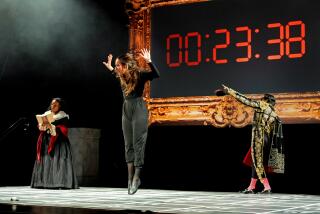Review: Long Beach Opera puts its own spin on ‘Thérèse Raquin’

Tobias Picker, whose “Thérèse Raquin” was revived by Long Beach Opera on Saturday night at the Warner Grand Theatre in San Pedro, is a New Yorker with a melodramatic style that seems to suit California. He is the only composer to have been commissioned by the state’s three leading opera companies.
Los Angeles Opera started the trend in 1998 with Picker’s cantankerous children’s opera, “Fantastic Mr. Fox.” In 2003, San Diego Opera gave the West Coast premiere of “Thérèse Raquin,” which the company co-commissioned. A decade later, San Francisco Opera unveiled Picker’s moody “Dolores Claiborne,” the first opera after a Stephen King novel.
------------
FOR THE RECORD:
Opera: In the Jan. 26 Calendar section, a review of the Long Beach Opera production of “Therese Raquin” said that the second and final performance was Jan. 25. The final performance will be Feb. 1. —
------------
Long Beach Opera’s “Thérèse Raquin” is another first of sorts, the West Coast premiere of Picker’s chamber orchestra version of the opera. But this remains, nevertheless, a peculiarly safe modern opera for a company that thrives on its reputation for feistiness. The fact that LBO is now in cahoots with Chicago Opera Theater for some productions — Andreas Mitisek is music director of both companies — may have something to do with some of Long Beach’s less-risky recent choices.
Indeed, Andrew Clark in the Financial Times called “Thérèse Raquin” a “genuine American opera par excellence,” meaning antiquated storytelling through bland music. And it is true that Picker and librettist Gene Scheer bring nothing newly shocking or original to Émile Zola’s story. But they are also secure in the fact that Zola’s salaciously erotic 19th century novel has never gone out of fashion. It has inspired more than a dozen movies and television dramas, along with any number of plays. The latest are the thriller “In Secret” and a hit London musical. There is also a 1993 opera by Michael Finnissy.
A diffident young woman obliged into an unhappy marriage with her sickly cousin Camille, Thérèse begins a torrid affair with her husband’s oldest friend. To get Camille out of the way, Thérèse and Laurent lure him onto a boat and throw him overboard. The lovers eventually marry, but guilt destroys their passion. Thérèse’s life goes from sad to mad with only a momentary interlude of lustful indulgence.
Zola said the novel’s characters were meant to represent different temperaments rather than individuals, which makes the story especially suitable for updating and adapting to different media. But Picker and Scheer stick dutifully to the original. Their setting is Paris, 1864. The libretto has rhyming couplets. On their wedding night, Thérèse and Laurent sing: “What we did can never by undone. / We have no choice but to live as one.”
Fortunately, Ken Cazan’s Long Beach production, which was repeated Sunday afternoon before being packed up for Chicago, finds a few successfully unexpected solutions to the opera’s historical convention. He updates the setting to Paris 1945, and thanks to Jacqueline Saint Anne’s costumes, Alan E. Muraoka’s painterly set and David Jacques’ occasionally lurid lighting, the opera doesn’t feel quite so old-fashioned.
Picker’s chamber orchestra reduction is another dramatic improvement, its theatrical tartness replacing all-purpose orchestral lushness. The vocal writing is often generic, and some of his most effective instrumental effects are reminiscent of the finest dramatic film scores. But Picker does have a knack for producing convincing atmosphere and narrative.
A particular challenge to mounting “Thérèse Raquin” is its gloomy opening, which is bogged down with exposition and unpleasantly sullen characters, including Camille’s bossy mother. Even the sex in the opera’s first scenes lacks fire.
Cazan’s production is naturalistic, focused and unfussy, true to his material. But he does have a couple of welcome sensationalist tricks up his sleeve. In their remorse, Thérèse and Laurent are haunted by Camille’s spirit. Cazan turns the ghost into a gory ghoul straight out of a horror film.
The Long Beach cast was largely on the operatic side. Vibrato-laden voices emphasized climactic points in phrases and weren’t reliably clear in delivering text. But musically, it was a strong night, aided by committed conducting by Mitisek. And the singers understood how to hold the stage.
Mary Ann Stewart let the fervor under Thérèse’s plain-Jane exterior slowly emerge until finally overwhelming her. Matthew DiBattista’s Camille excellently conveyed a fine-grained snootiness. Ed Parks’ Laurent was a study in the false security of virility. Suzan Hanson brought an irresistibly irking monstrousness to Madame Lisette Raquin.
As Suzanne, Ani Maldjian used her soaring soprano to provide an object lesson for the reticent Thérèse’s in expression of emotion. Suzanne’s hapless police officer husband, Olivier, and the family friend Grivet supplied the evening’s fleeting moments of amusement, thanks, respectively to Zeffin Quinn Hollis and John Matthew Myers.
Twitter: @markswed
More to Read
The biggest entertainment stories
Get our big stories about Hollywood, film, television, music, arts, culture and more right in your inbox as soon as they publish.
You may occasionally receive promotional content from the Los Angeles Times.







